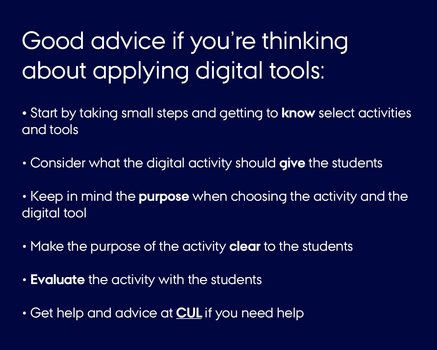Get started with Educational IT
Educational IT can help elevate the teaching and ensure a better learning process for the students. And getting started with the different digital tools is actually not that difficult. CUL continuously gathers tools and guidelines at the online resource TREAT (http://treat.au.dk) and also offers help, guidance and support throughout the semester.

There are many good reasons for using digital tools in the teaching. They can contribute to varying the teaching, increasing student involvement and not least strengthening the students’ learning process before, during and after class. It can, however, be difficult to get an overview of the many digital opportunities and how to use them. That’s why the Centre for Teaching and Learning (CUL) has developed the online resource TREAT (treat.au.dk), which contains an overview of easy-to-use tools, suggestions for activities, step-by-step guidelines, cases and much more.
Suitable for lectures and large classes
The purpose of using digital tools in the teaching is to ensure the best possible learning for the students under the given conditions for a course. According to Dorte Sidelmann Rossen, who is Educational IT team leader at CUL, teachers who are considering using digital tools, must take an outset in the course’s learning objectives and the form of instruction - i.e. whether it is classroom teaching or lectures. In many ways, the latter is particularly challenging for both the lecturer and the students:
“In large classes and lectures, it can often be very challenging to include all students and get an insight into what the students are struggling with,” says Dorte Sidelmann Rossen. “Here it can be a very good idea to use digital tools, such as AU Vote (Mentimeter) or other student response systems. They give the lecturer an idea of whether the students have understood the material, and also give him or her a chance to adapt the teaching accordingly. Lecturers can also make use of different peer-to-peer activities in which the students become actively involved in the lecture e.g. through discussions or feedback exercises.”

Think digitally before, during and after classes
In other words, digital tools can help solve various teaching challenges. They can contribute to training the students’ academic understanding, helping specific target groups or creating greater flexibility in the course.
In fact, using digital tools is also a good idea outside of the actual classes. According to Dorte Sidelmann Rossen, it is just as important to place digital activities in between classes, so as to ensure the most appropriate learning process throughout the semester. The lecturer may put short videos on Blackboard where he or she provide student instructions or explain a particularly complex theory. Here CUL also offers to help, as the department has its own Media Lab, which records and edits the video.
“Spending time on digital activities during and in between classes can be a very good investment for both the lecturer and the students,” says Dorte Sidelmann Rossen.”Digital teaching activities in between classes can be organised so that the students are better prepared for the actual class. In this way, the lecturer can make the most of the limited amount of time that he or she actually spends with the students. At the same time, the students often feel a greater sense of involvement, which ultimately contributes to a better learning process.”
Ongoing help and advice
As a lecturer, you can get help and advice as well as technical support from CUL throughout the semester. CUL is also very interested in collaborating with teaching teams who would like to incorporate blended learning, which combines digital teaching activities and traditional teaching, on degree programme level.
For more information:
Visit TREAT
Read more about CUL or get help and advice
Read more about Educational IT
Read more about the course in blended learning
Contakt the Media Lab